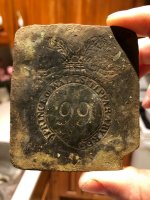BladeRunner2019
Hero Member
- Dec 22, 2013
- 744
- 1,774
- Detector(s) used
- XP Deus, Equinox 800
- Primary Interest:
- Metal Detecting
Found this today at a skirmish site that has been hit hard over the years by others. Any information or suggestions on what to do with it would be appreciated.
Weight is approximately 8.9 pounds. Diameter is roughly 4.75 inches.
Other than a canister shot, this is my first artillery of any kind.
Thanks for any insight.

Gratuitous dirt porn. Those roots were tough.
Those roots were tough.

Weight is approximately 8.9 pounds. Diameter is roughly 4.75 inches.
Other than a canister shot, this is my first artillery of any kind.
Thanks for any insight.

Gratuitous dirt porn.
 Those roots were tough.
Those roots were tough.
Upvote
0






 Your expertise is much appreciated around here.
Your expertise is much appreciated around here.





